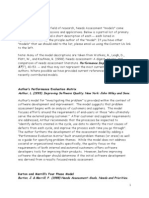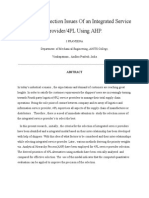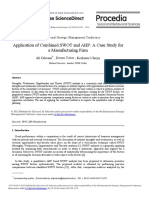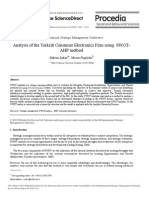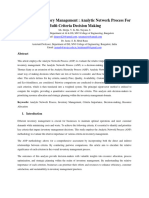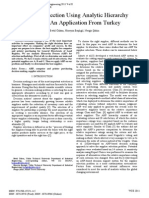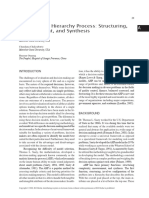Ahp in Assessing Performance of Diploma Institutes - A Case Study
Ahp in Assessing Performance of Diploma Institutes - A Case Study
Uploaded by
aswardiCopyright:
Available Formats
Ahp in Assessing Performance of Diploma Institutes - A Case Study
Ahp in Assessing Performance of Diploma Institutes - A Case Study
Uploaded by
aswardiOriginal Description:
Original Title
Copyright
Available Formats
Share this document
Did you find this document useful?
Is this content inappropriate?
Copyright:
Available Formats
Ahp in Assessing Performance of Diploma Institutes - A Case Study
Ahp in Assessing Performance of Diploma Institutes - A Case Study
Uploaded by
aswardiCopyright:
Available Formats
Vol. 3, No.
2| December 2011| ISSN 2229-8932 Journal of Technical Education and Training (JTET) | 67
AHP IN ASSESSING PERFORMANCE OF DIPLOMA INSTITUTES A
CASE STUDY
Sujit Kumar Goshal
Jadavpur University, Kolkata, India
Sukanta Kumar Naskar
Nitttr-Kolkata, India
Dipankar Bose
Nitttr-Kolkata, India
ABSTRACT
Present paper shows application of Analytical Hierarchy Process (AHP) as potential tool in decision making in
assessing performance of diploma institutes. AHP decompose the decision problem into a hierarchy of more
easily comprehended sub-problems, each of which can be analyzed independently. The elements of the
hierarchy can relate to any aspect of the decision problem. Assessment of diploma level institutes based on
certain parameters is used as example where AHP application has been made. A hierarchical structure is
framed for the parameters and the diploma institutes from where feedback received against the parameters for
this study. By applying the AHP, the parameters are prioritized and a descending order list of diploma institutes
is made in order to identify the best performing institutes. Step by step approach for applying AHP has been be
used by using AHP Calculation Software. It is expected that this study will encourage the users in applying AHP
in assessing institutional performance of similar institutions.
Keywords: Analytical hierarchy process (AHP), Diploma institutes, Performance assessment, Decision making
Vol. 3, No.2| December 2011| ISSN 2229-8932 Journal of Technical Education and Training (JTET) | 68
1 INTRODUCTION
The Analytical Hierarchy Process (AHP)
is a decision-aiding method developed by Saaty It
aims at quantifying relative priorities for a given set of alternatives on a ratio Scale, based on
the judgment of the decision-maker, and stresses the importance of the intuitive Judgments of
a decision-maker as well as the consistency of the comparison of alternatives in the decision-
making process [Since a decision-maker bases judgments on knowledge and experience, then
makes decisions accordingly, the AHP approach agrees well with the behaviour of a decision-
maker. The strength of this approach is that it organizes tangible and intangible factors in a
systematic way, and provides a structured yet relatively simple solution to the decision-
making problems In addition, by breaking a problem down in a logical fashion from the
large, descending in gradual steps, to the smaller and smaller, one is able to connect, through
simple paired comparison judgments, the small to the large.
The objective of this paper is to introduce the application of the AHP in assessing
institutional performance of some selected diploma level institutes in West Bengal (a state in
the Eastern part of India). The paper will briefly review the concepts and applications of the
multiple criteria decision analysis, the AHP's implementation steps, and demonstrate AHP
application on the ranking some diploma level institutions with respect to some selected
parameters. It is hoped that this will encourage its application in the similar cases.
2 MULTIPLE CRITERIA DECISION ANALYSIS (MCDA)
Administrators are faced with decision environments and problems in assessing
organizational performance that are complex. The elements of the problems are numerous,
and the interrelationships among the elements are extremely complicated. Relationships
between elements of a problem may be highly nonlinear; changes in the elements may not be
related by simple proportionality. Furthermore, human value and judgement systems are
integral elements of similar problems Therefore, the ability to make sound decisions in
finding and selecting criteria for assessing organizational performance is very important to
the success of effort. In fact, it a skill that is certainly near the top of the list of decision
making skills, and notices that few of us have had formal training in decision making.
Multiple criteria decision-making (MCDM) approaches are major parts of decision
theory and analysis. They seek to take explicit account of more than one criterion in
supporting the decision process. The aim of MCDM methods is to help decision-makers learn
about the problems they face, to learn about their own and other parties' personal value
systems, to learn about organizational values and objectives, and through exploring these in
the context of the problem to guide them in identifying a preferred course of action . In other
words, MCDA is useful in circumstances which necessitate the consideration of different
courses of action, which can not be evaluated by the measurement of a simple, single
dimension. Hwang and Yoon published a comprehensive survey of multiple attribute decision
making methods and applications.
Two types of the problems that are common in the assessment of institutional
performance that best fit MCDA models are evaluation problems and design problems. The
Vol. 3, No.2| December 2011| ISSN 2229-8932 Journal of Technical Education and Training (JTET) | 69
evaluation problem is concerned with the evaluation of, and possible choice between,
discretely defined alternatives. The design problem is concerned with the identification of a
preferred alternative from a potentially infinite set of alternatives implicitly defined by a set
of constraints.
3 THE ANALYTICAL HIERARCHY PROCESS (AHP)
Belton compared AHP and a simple multi-attribute value (MAV), as two of the multiple
criteria approaches. She noticed that both approaches have been widely used in practice
which can be considered as a measure of success. She also commented that the greatest
weakness of the MAV approach is its failure to incorporate systematic checks on the
consistency of judgments. She noticed that for large evaluations, the number of judgments
required by the AHP can be somewhat of a burden. A number of criticisms have been
launched at AHP over the years. Watson and Freeling said that in order to elicit the weights
of the criteria by means of a ratio scale, the method asks decision-makers meaningless
questions, for example: `Which of these two criteria is more important for the goal? By how
much?' Belton and Gear and Dyer pointed out that this method can suffer from rank reversal
(an alternative chosen as the best over a set of X, is not chosen when some alternative,
perhaps an unimportant one, is excluded from X). Belton and Gear and Dyer and Wendel
attacked the AHP on the grounds that it lacks a firm theoretical basis. Harker and Vargas and
Perez discussed these major criticisms and proved with a theoretical work and examples that
they are not valid. They commented that the AHP is based upon a firm theoretical foundation
and, as examples in the literature and the day-to-day operations of various governmental
agencies, corporations and consulting firms illustrate, the AHP is a viable, usable decision-
making tool. Saaty developed the following steps for applying the AHP:
1. Define the problem and determine its goal.
2. Structure the hierarchy from the top (the objectives from a decision-maker's
viewpoint) through the intermediate levels (criteria on which subsequent levels
depend) to the lowest level which usually contains the list of alternatives.
3. Construct a set of pair-wise comparison matrices (size n x n) for each of the lower
levels with one matrix for each element in the level immediately above by using the
relative scale measurement shown in Table 1. The pair-wise comparisons are done in
terms of which element dominates the other.
4. There are n (n -1) / judgments required to develop the set of matrices in step 3.
Reciprocals are automatically assigned in each pair-wise comparison.
5. Hierarchical synthesis is now used to weight the eigenvectors by the weights of the
criteria and the sum is taken over all weighted eigenvector entries corresponding to
those in the next lower level of the hierarchy.
6. Having made all the pair-wise comparisons, the consistency is determined by using
the eigenvalue,
max
, to calculate the consistency index, CI as follows: CI=(
max
n)
Vol. 3, No.2| December 2011| ISSN 2229-8932 Journal of Technical Education and Training (JTET) | 70
/ (n-1), where n is the matrix size. Judgment consistency can be checked by taking the
consistency ratio (CR) of CI with the appropriate value in Table 2. The CR is
acceptable, if it does not exceed 0.10. If it is more, the judgment matrix is
inconsistent. To obtain a consistent matrix, judgments should be reviewed and
improved.
7. Steps 3-6 are performed for all levels in the hierarchy.
Table 1: Pair-Wise Comparison Scale for AHP Preferences
Numerical rating Verbal judgments of
preferences
9 Extremely preferred
8
7
Very strongly to extremely
6
Very strongly preferred
5
Strongly to very strongly
4
Strongly preferred
3
Moderately to strongly
2
Moderately preferred
1
Equally to moderately
Equally preferred
Table 2: Average Random Consistency (RI)
Size of matrix 1 2 3 4 5 6 7 8 9 10
Random 0 0 0.58 0.9 1.12 1.24 1.32 1.41 1.45 1.49
Consistency
Fortunately, there is no need to implement the steps manually. Professional
commercial software is available on the market which simplifies the implementation of the
AHP's steps and automates many of its computations (AHP Calculation Software by CGI -
web-based free software or Expert Choice, developed by Expert Choice, Inc.).
3.1 Group decision making
The AHP allows group decision making, where group members can use their experience,
values and knowledge to break down a problem into a hierarchy and solve it by the AHP
steps. Brainstorming and sharing ideas and insights (inherent in the use of Expert Choice in a
group setting) often leads to a more complete representation and understanding of the issues.
The following suggestions and recommendations are suggested in the Expert Choice software
manual.
1. Group decisions involving participants with common interests are typical of many
organizational decisions. Even if we assume a group with common interests,
individual group members will each have their own motivations and, hence, will be in
conflict on certain issues. Nevertheless, since the group members are `supposed' to be
striving for the same goal and have more in common than in conflict, it is usually best
Vol. 3, No.2| December 2011| ISSN 2229-8932 Journal of Technical Education and Training (JTET) | 71
to work as a group and attempt to achieve consensus. This mode maximizes
communication as well as each group member's stake in the decision.
2. An interesting aspect of using Expert Choice is that it minimizes the difficult
problem of groupthink or dominance by a strong member of the group. This occurs
because attention is focused on a specific aspect of the problem as judgments are
being made, eliminating drift from topic to topic as so often happens in group
discussions. As a result, a person who may be shy and hesitant to speak up when a
group's discussion drifts from topic to topic will feel more comfortable in speaking up
when the discussion is organized and attention turns to his area of expertise. Since
Expert Choice reduces the influences of groupthink and dominance, other decision
processes such as the well known Delphi technique may no longer be attractive. The
Delphi technique was designed to alleviate groupthink and dominance problems.
However, it also inhibits communication between members of the group. If desired,
Expert Choice could be used within the Delphi context.
3. When Expert Choice is used in a group session, the group can be shown a hierarchy
that has been prepared in advance. They can modify it to suit their understanding of
the problem. The group defines the issues to be examined and alters the prepared
hierarchy or constructs a new hierarchy to cover all the important issues. A group
with widely varying perspectives can feel comfortable with a complex issue, when the
issue is broken down into different levels. Each member can present his own concerns
and definitions. Then, the group can cooperate in identifying the overall structure of
the issue. In this way, agreement can be reached on the higher-order and lower-order
objectives of the problem by including all the concerns that members have expressed.
The group would then provide the judgments. If the group has achieved consensus on
some judgment, input only that judgment. If during the process it is impossible to
arrive at a consensus on a judgment, the group may use some voting technique, or
may choose to take the `average' of the judgments. The group may decide to give all
group members equal weight, or the group members could give them different
weights that reflect their position in the hierarchy. All calculations are done
automatically on the computer screen.
4. The Group Meeting: While Expert Choice is an ideal tool for generating group
decisions through a cohesive, rigorous process; the software does not replace the
components necessary for good group facilitation. There are a number of different
approaches to group decision-making, some better than others. Above all, it is important
to have a meeting in which everyone is engaged, and there is buy-in and consensus with
the result.
4 APPLICATION OF THE AHP IN ASSESSING INSTITUTIONAL
PERFORMANCE
In this paper, contributing parameters (an evaluation problem) will be used as an example of
the possibility of using AHP in assessing institutional performance. Performance of any
institutes is normally done by considering some contributing parameters (criterion), not by a
Vol. 3, No.2| December 2011| ISSN 2229-8932 Journal of Technical Education and Training (JTET) | 72
single parameter. AHP is a suitable technique deals with multiple decision parameters to
arrive at the best alternative where all the alternatives are judged on the basis of all the
decision parameters. Assessment of diploma level institutions is viewed as a multi-criteria
decision making problem where AHP technique can suitably be applied. Here important
aspect is to find out the contributing parameters and putting subjective weightage to them
accordingly details approach for doing so are described in the subsequent sections of this
paper.
4.1 Selection of contributing parameters in assessing institutional performance
Parameters which reflect the institutional level performance are likely to differ depending on
whose view points are taken. Different stake holders have different viewpoints regarding
parameters selection for assessing the institutional level performance. However,
Georgopoloares and Tannenbaun (1957), Caplow (1964), Friendander and Pickle (1968),
Mott (1972), and Duncan (1973) are those who suggest that institutional performance and
effectiveness are generally to be assessed by some common criteria irrespective of the types
of organizations. Other researchers opined that, the organizations have different
characteristics, goals, and constituencies and as a result each type of organization requires a
unique set of criteria to judge the organizational performance and effectiveness (Rice, 1961;
Hall, 1972; Scott, 1977).
To arrive at the parameters for assessing the institutional level performance of the
diploma level institutions a few senior administrators and faculty members of the system
were interviewed based on structured questionnaire for suggesting some common factors
which reflects the institutional performance. While interviewing special emphasis was given
on criteria relating to the organizational level analysis. Certain cluster of items became
predominant as the criteria emerged from the interviews and on the basis of that seven
separate groupings of criteria were framed. Criterion combination is based on value
judgements, without any algorithm or higher order truth to which we can appeal (Campbell,
1977). Several alternative groupings were tried but the grouping in the present case
represents the most suitable one which reflects all possible criteria of institutional
performance list of such criteria is as follows:
Academic Environment and Freedom- AFE
Affiliation and Belongingness- A&B
Strategic- Str.
Student Guidance and Counselling- SGC
System Openness and Stake holders Interactions- SOSI
Support and Structure- SS
4.2 Rating of decision alternatives
Rating of diploma institutes (alternatives) as satisfied each parameter is done by
administering an instrument to a sample group of people of different levels associated in
diploma education system of West Bengal. All items used in the instrument are directly
Vol. 3, No.2| December 2011| ISSN 2229-8932 Journal of Technical Education and Training (JTET) | 73
related to the assessment criteria as selected before hand and are assigned five point scale
where 5 denotes strongly agree and 1 represents strongly disagree.
By using Weighted Average Method (WAG) - a simple statistical calculation, institute wise
average score were calculated (Table 3). Average score for respective institutes were used for
rating the diploma institutes as mentioned above. For example in case of Polytechnic 1 (P1)
average scores are 1.72, 2.31, 4.34, 4.55, 3.98, and 2.92 for criteria- Academic Environment
and Freedom, Affiliation and Belongingness, Strategic ,Student Guidance and Counselling,
System Openness and Stake holders Interactions, Support and Structure respectively. Instead
of putting subjective weight-age to all the contributing parameters based on the individuals
experience the average scores could be used while putting the same (subjective weight-age)
for applying AHP in the subsequent sections.
Table 3: Institute Wise Average Scoring of Six Dimensions
Diploma Institutes Dimensions
A B C D E F
P1: Polytechnic 1 1.72 2.31 4.34 4.55 3.98 2.29
P2: Polytechnic 2 1.99 3.05 1.78 2.96 4.07 3.30
P3: Polytechnic 3 3.97 4.36 2.92 2.58 1.23 2.23
P4: Polytechnic 4 4.79 4.07 4.46 2.031 3.13 4.39
P5: Polytechnic 5 2.9 1.01 1.20 1.39 2.43 1.19
5 EXAMPLE
A simplified problem assessing institutional performance as example will be demonstrated
here for illustration purposes. To simplify calculations, the factors that will be used in this
case and selected as contributing parameters are:
Academic Environment and Freedom- AFE
Affiliation and Belongingness- A&B
Strategic- Str.
Student Guidance and Counselling- SGC
System Openness and Stake holders Interactions- SOSI
Support and Structure- SS
Other criteria can be added if necessary, together with a suggestion that a computer be
used to simplify calculations.
Table 4 represents an example of assessment of institutional performance for which
alternatives (polytechnics) are considered. Table 4 is developed based on the data available
and presented in table 1 (Pair-wise comparison scale for AHP preferences) above. In this
case, an argument could be presented that polytechnic 5 is not meeting the minimum criteria.
Descriptions presented in Table 4 under ` polytechnic 5 ', such as `very bad support
structure, `student guidance & counselling' and affiliation & belongingness, qualifies it for
immediate elimination from the list by the alternatives. Nevertheless, it is the choice of the
decision-maker to eliminate polytechnic 5 immediately since it does not qualify the minimum
criteria. Polytechnic 5 could be left on the list (the choice in this paper for demonstration
Vol. 3, No.2| December 2011| ISSN 2229-8932 Journal of Technical Education and Training (JTET) | 74
purposes) so that he appears at the end of the list of `best polytechnics in descending order',
as will be shown at the end of the example. The matter is safeguarded by checking the
consistency of the pair-wise comparison which is a part of the AHP procedure.
By following the AHP procedure described in the Section 5, the hierarchy of the
problem can be developed as shown in Fig. 1. For step 3, the decision-makers have to
indicate preferences or priority for each decision alternative in terms of how it contributes to
each criterion as shown in Table 5.
Table 4: Pair Wise Comparison of Alternatives (Polytechnics) - An Example
Polytechnic
1
Polytechnic
2
Polytechnic
3
Polytechnic
4
Polytechnic
5
Academic
Environment
and Freedom
very poor poor good very good average
Affiliation and
Belongingness
bad average very good good very bad
Strategic Very good low average good very low
Student
Guidance and
Counselling
Very good average good bad very bad
System
Openness and
Stake holders
Interactions
strong very strong very low average low
Support and
Structure
bad average good very good very bad
Vol. 3, No.2| December 2011| ISSN 2229-8932 Journal of Technical Education and Training (JTET) | 75
Figure: 1 Hierarchy of the Problem (Example)
Then, the following can be done manually or automatically by the AHP software:
1. Synthesizing the pair-wise comparison matrix (example: Table 6);
2. Calculating the priority vector for a criterion such as experience (example: Table 6);
3. Calculating the consistency ratio;
4. Calculating
max
5. Calculating the consistency index, CI;
;
6. Selecting appropriate value of the random consistency ratio from Table 2; and
7. Checking the consistency of the pair-wise comparison matrix to check whether the
decision-maker's comparisons were consistent or not.
Table 5: Pair-Wise Comparison Matrix for Academic Environment & Freedom- AEF
AEF P1 P2 P3 P4 P5
P1 1 1/3 1/2 1/6 2
P2 3 1 2 1/2 4
P3 2 1/2 1 1/3 3
P4 6 2 3 1 7
P5 1/2 1/4 1/3 1/7 1
Level 2: Criteria
Level 3: Polytechnics
P1
P2
P3
P4
P5
P1
P2
P3
P4
P5
P1
P2
P3
P4
P5
P1
P2
P3
P4
P5
P1
P2
P3
P4
P5
P1
P2
P3
P4
P5
AEF A&B Str. SGC SOSI SS
Level 1: Goal
Selecting the best performing polytechnic
AEF =Academic Env. & freedom
Str.=Strategic
SOSI=System openness & stake holders interaction
A&B =Affiliation & belongingness
SGC =Student guidance & counselling
SS=Support & Structure
P1,P2,P3,P4 and P5 are the polytechnics performance to be measured.
Vol. 3, No.2| December 2011| ISSN 2229-8932 Journal of Technical Education and Training (JTET) | 76
The calculations for these items will be explained next for illustration purposes.
Synthesizing the pair-wise comparison matrix is performed by dividing each element of the
matrix by its column total. For example, the value 0.08 in Table 6 is obtained by dividing 1
(from Table 5) by 12.5, the sum of the column items in Table 5 (1 +3 +2 +6 +1/2).
The priority vector in Table 6 can be obtained by finding the row averages. For
example, the priority of polytechnic P1 (alternative 1) with respect to the criterion Academic
Environment and Freedom in Table 6 is calculated by dividing the sum of the rows (0.08 +
0.082 +0.073 + 0.078 +0.118) by the number of contractors (columns), i.e., 5, in order to
obtain the value 0.086. The priority vector for experience, indicated in Table 6, is given
below.
055 . 0
457 . 0
152 . 0
249 . 0
086 . 0
(1)
Now, estimating the consistency ratio is as follows:
Table 6: Synthesized Matrix for Academic Environment & Freedom
AEF P1 P2 P3 P4 P5 Priority
vector
P1 0.08 0.082 0.073 0.078 0.118 0.086
P2 0.24 0.245 0.293 0.233 0.235 0.249
P3 0.16 0.122 0.146 0.155 0.176 0.152
P4 0.48 0.489 0.439 0.466 0.412 0.457
P5 0.04 0.061 0.049 0.066 0.059 0.055
=0.999
max.
5:037, CI . 0:00925, RI . 1:12, CR . 0:0082 <0:1 OK.
( ) Matrix Sum weighted
276 . 0
312 . 2
766 . 0
259 . 1
431 . 0
1
7
3
4
2
055 . 0
7 / 1
1
3 / 1
2 / 1
6 / 1
457 . 0
3 / 1
3
1
2
2 / 1
152 . 0
4 / 1
2
2 / 1
1
3 / 1
249 . 0
2 / 1
6
2
3
1
086 . 0
(2)
Dividing all the elements of the weighted sum matrices by their respective priority vector
element, we obtain:
012 . 5
086 . 0
431 . 0
= , 056 . 5
249 . 0
259 . 1
= , 039 . 5
152 . 0
766 . 0
= , 059 . 5
457 . 0
312 . 2
=
,
018 . 5
055 . 0
276 . 0
= (3)
We then compute the average of these values to obtain
max.
Vol. 3, No.2| December 2011| ISSN 2229-8932 Journal of Technical Education and Training (JTET) | 77
max
=
5
018 . 5 059 . 5 039 . 5 056 . 5 012 . 5 + + + +
=5.037 (4)
Now, we find the consistency Index, CI as follows:
00925 . 0
1 5
5 037 . 5
1
max
=
=
n
n
CI
(5)
Selecting appropriate value of random consistency ratio, RI, for a matrix size of five using
Table 2, we find RI =1.12. We then calculate the consistency ratio, CR, as follows:
CR =CI/RI =0.00925/ 1.12 =0.0082 (6)
Table 7: Pair-Wise Comparison Matrix for Affiliation & Belongingness- A&B
A&B P1 P2 P3 P4 P5 Priority
vector
P1 1 6 3 2 7 0.425
P2 1/6 1 1/4 1/2 3 0.088
P3 1/3 4 1 1/3 5 0.178
P4 1/2 2 3 1 7 0.268
P5 1/7 1/3 1/5 1/7 1 0.039
=0.998
max.
=5.32, CI =0.08, RI =1.12, CR=0.071<0:1 OK.
Table 8:Pair-Wise Comparison Matrix for Strategic- STR.
Str. P1 P2 P3 P4 P5 Priority
vector
1 P1 7 1/3 2 8 0.269
1/7 P2 1 1/5 1/4 4 0.074
3 P3 5 1 4 9 0.461
1/2 P4 4 1/4 1 6 0.163
1/8 P5 1/4 1/9 1/6 1 0.031
=0.998
max.
=5.38, CI =0.095, RI =1.12, CR=0.085<0:1 OK.
As the value of CR is less than 0.1, the judgments are acceptable. Similarly, the pair-
wise comparison matrices and priority vectors for the remaining criteria can be found as
shown in Tables 7-11, respectively.
In addition to the pair-wise comparison for the decision alternatives, we also use the
same pair-wise comparison procedure to set priorities for all six criteria in terms of
importance of each in contributing to the overall goal. Table 12 shows the pair-wise
comparison matrix and priority vector for the six criteria.
Vol. 3, No.2| December 2011| ISSN 2229-8932 Journal of Technical Education and Training (JTET) | 78
Now, the software can do the rest automatically, or we manually combine the
criterion priorities and the priorities of each decision alternative relative to each criterion in
order to develop an overall priority ranking of the decision alternative which is termed as the
priority matrix (Table 13). The calculations for finding the overall priority of contractors are
given below for illustration purposes:
Overall priority of alternative 1 (polytechnic- P1)
=0.372(0.086) +0.293(0.425) +0.156(0.269) +0.053(0.151)
+0.039(0.084) +0.087(0.144) =0.222 (7)
Table 9: Pair-Wise Comparison Matrix for Student Guidance & Counselling- SGC
SGC
P1 P2 P3 P4 P5 Priority
vector
P1 1 1/2 1/4 2 5 0.151
P2 2 1 1/3 5 7 0.273
P3 4 3 1 4 6 0.449
P4 1/2 1/5 1/4 1 2 0.081
P5 1/5 1/7 1/6 1/2 1 0.045
=0.999
max.
=5.24, CI =0.059, RI =1.12, CR=0.053<0:1 OK.
Overall priority of alternative 2 (polytechnic P2)
=3.372(0.249) +0.293(0.088) +0.156(0.074) +0.053(0.273)
+0.039(0.264) +0.087(0.537) =0.201 (8)
Table 10: Pair-Wise Comparison Matrix for System Openness and Stakeholders Opinions-
SOSI
SOSI P1 P2 P3 P4 P5 Priority
vector
P1 1 1/6 1/8 2 3 0.084
P2 6 1 1/4 5 7 0.264
P3 8 4 1 9 9 0.556
P4 1/2 1/5 1/9 1 2 0.057
P5 1/3 1/7 1/9 1/2 1 0.038
=0.999
max.
=5.28, CI =0.071, RI =1.12, CR=0.063<0:1 OK.
Vol. 3, No.2| December 2011| ISSN 2229-8932 Journal of Technical Education and Training (JTET) | 79
Table 11: Pair-Wise Comparison Matrix for Support & Structure- SS
SS P1 P2 P3 P4 p5 Priority
vector
P1 1 1/5 1/3 3 3 0.144
P2 5 1 5 6 6 0.537
P3 3 1/5 1 2 2 0.173
P4 1/3 1/6 1/2 1 2 0.084
P5 1/3 1/6 1/2 1/2 1 0.062
=0.999
max.
=5.40, CI =0.10, RI =1.12, CR=0.089<0:1 OK.
Table 12: Pair-Wise Comparison Matrix for Six Criteria
AEF A&B Str. SGC SOSI SS Priority
vector
AEF 1 2 3 6 6 5 0.372
AXB 1/2 1 3 6 6 5 0.293
Str. 1/3 1/3 1 4 4 3 0.156
SGC 1/6 1/6 1 2 1/2 0.053
SOSI 1/6 1/6 1 0.039
SS 1/5 1/5 1/3 2 4 1 0.087
=1.00
max.
=6.31, CI =0.062, RI =1.24, CR=0.05<0:1 OK.
Overall priority of alternative 3 (polytechnic P3)
=0.372(0.152) +0.293(0.178) +0.156(0.461) +0.053(0.449)
+0.039(0.556) +0.087(0.173) =0.241 (9)
Overall priority of alternative 4 (polytechnic P4)
=0.372(0.457) +0.293(0.268) +0.256(0.163) +0.053(0.081)
+0.039(0.057) +0.087(0.084) =0.288 (10)
Overall priority of alternative 5 (polytechnic P5)
=0.372(0.055) +0.293(0.039) +0.156(0.031) +0.053(0.045)
+0.039(0.038) +0.087(0.062) =0.046 11)
Table 13: Priority matrix for Assessment of Performance
AEF
AEF A&B Str. SGC SOSI SS Overall Priority
vector
P1 0.086 0.425 0.269 0.151 0.084 0.144 0.222
P2 0.249 0.088 0.074 0.273 0.264 0.537 0.201
P3 0.152 0.178 0.461 0.449 0.556 0.173 0.241
P4 0.457 0.268 0.163 0.081 0.057 0.084 0.288
p5 0.055 0.039 0.031 0.045 0.038 0.062 0.046
Vol. 3, No.2| December 2011| ISSN 2229-8932 Journal of Technical Education and Training (JTET) | 80
For taking decisions, the polytechnic institutes under considerations are now ranked
according to their overall priorities, as follows: P4, P3, P1, P2, and P5, indicate that P4 is the
best in terms of performance.
6 CONCLUSION
Assessment of performance and making rank of institutes is a complex decision making
process that requires discerning abilities and methods to make sound decisions. The paper has
presented the Analytical Hierarchy Process (AHP) as a decision-making method that allows
the consideration of multiple criteria. An example of diploma institutes and their performance
was created to demonstrate AHP application in assessing institutional performance of
diploma institutes.
Assessing performance involves criteria and priorities that are determined by user
requirements and preferences as well as the characteristics of the individual institutes. AHP
allows group decision-making. The AHP is now used as common tool in multi-criteria
decision making process as a part of operation research and management science because of
its both technically validity and practical usefulness.
Some formidable problems stand as obstacles to the selection of common criteria to
assess the institutional performance, because it is very difficult to specify appropriate,
measurable parameters which reflect the institutional performance. Findings in the study are
preliminary and exploratory, but they do suggest some directions for similar study that may
both enhance understanding of institutional level environment and help to improve the
performance. Results shown are not the true reflections of diploma education systems,
indicative only. No general conclusion can be made out of these findings to the diploma
education system of the state as mentioned.
7 REFERENCES
Aitah, R.A. (1988). Performance study of lowest bidder bid awarding system in government projects. Master
thesis, King Fahd University of Petroleum and Minerals, KFUPM, Dhahran, Saudi Arabia, 1988
Bhushan, N. and Kanwal R. (January 2004). Strategic Decision Making: Applying the Analytic Hierarchy
Process. London: Springer-Verlag. ISBN 1-8523375-6-7
Belton, V. (1990). Multiple criteria decision analysis - practically the only way to choose. In: Hendry LC,
Eglese RW, editors. Operational Research Tutorial Papers. 1990, pp. 53-102
Belton, V. and Gear, T. (1983). On a shortcoming of Saaty's method of analytical hierarchy. Omega 1983;
11(3):228-30.
Belton, V. and Gear T. (1985) The legitimacy of rank reversal- a comment. Omega 1985; 13(3):143-4.
Cameron, K.S. (1981). Domains of organizational effectiveness in colleges and universities. Academy of
Management Journal
24: 25-47
Vol. 3, No.2| December 2011| ISSN 2229-8932 Journal of Technical Education and Training (JTET) | 81
Cameron, K.S. (1986). A study of organizational effectiveness and its predictors. Management Science
32(1):
87-112
Cameron, K.S., and Ettington, D.R. (1988). The conceptual foundations of organizational culture. In: Smart,
J.C. (ed.), Higher Education: Handbook of Theory and Research
(Vol. 4). Agathon Press, New York,
pp. 356-396.
Cameron, K.S. and Whetten, D.A. (1983). Organizational Effectiveness: A Comparison of Multiple Models,
Academic Press, New York.
Dyer J.S. and Wendel, R.E. (1985). A critique of the analytical hierarchy process. Working Paper 84/85-4-24,
Department of Management, The University of Texas at Austin, 1985
Duncan, Robert B. (1973). Multiple decision-making structures in adapting to environmental uncertainty: the
impact on organizational effectiveness. Human Relations, 26: 273-291.
Expert Choice, Inc., Expert Choice software and manual. 4922 Elsworth Ave., Pittsburgh, PA 15213, USA
Hwang CL, Yoon K. (1981). Multiple attribute decision making: Methods and applications: A-State-of-the-Art
Survey. Berlin: Springer-Verlag, 1981.
Johnes, J., and Taylor, J. (1990). Performance Indicators in Higher Education,
Open University Press, Bristol,
PA.
Khaparde, M.S., Srivastava, A.K., and Meganathan, R. (2004). Successful School Management: Case Studies of
Selected Navodaya Vidyalayas.
New Delhi: National Council of Educational Research and Training.
Kwan, P. (2002). An investigation of the relationship between organizational culture and organizational
effectiveness in Hong Kong higher education institutions, Doctorate dissertation. The Chinese
University of Hong Kong, HKSAR, China.
Lysons, A. (1990b). Dimensions and domains of organizational effectiveness in Australian higher education.
Higher Education: The International Jurnal of Higher Education and Educational Planning
20(3):
287-300
Lysons, A., Hatherly, D. and Mitchell, D.A. (1998). Comparison of measures of organizational effectiveness in
U.K. higher education. Higher Education
36(1): 1-19
Navodaya vidyalaya samiti annual report (2003). New Delhi: Navodaya Vidyalaya Samiti.
Nguyen, V.V. (1985). Tender evaluation by fuzzy sets. Journal of Construction Engineering and Management,
ASCE 1985; 3(3):231-43.
Saaty, T. L. The analytic hierarchy process. New York: McGrawHill, 1980.
Saaty, T. L. (2008-06). Relative Measurement and its Generalization in Decision Making: Why Pairwise
Comparisons are Central in Mathematics for the Measurement of Intangible Factors - The Analytic
Hierarchy/Network Process. RACSAM (Review of the Royal Spanish Academy of Sciences, Series A,
Mathematics) 102 (2): 251318
.
Saaty, T.L. (1990). How to make a decision: the analytic hierarchy process. European Journal of Operational
Research, North-Holland 1990; 48:9-26.
Watson, S.R., Buede D.M. (1987). Decision synthesis: the principles and practice of decision analysis.
Cambridge: Cambridge University Press, 1987.
Zeleny, M. (1990). Multiple criteria decision making. New York: McGraw-Hill.
You might also like
- ModelsDocument10 pagesModelsjohar7766No ratings yet
- The Trials and Tribulations of Performance AppraisalDocument5 pagesThe Trials and Tribulations of Performance AppraisalAiuza Naa Sii MenthilNo ratings yet
- Performance Evaluation Systems: Absolute Vs ComparativeDocument6 pagesPerformance Evaluation Systems: Absolute Vs ComparativeSyedaShaguftaNo ratings yet
- Msie 08 L M2S1Document23 pagesMsie 08 L M2S1Souha BennaniNo ratings yet
- Simple Additive Weighting Approach To Personnel Selection ProblemDocument5 pagesSimple Additive Weighting Approach To Personnel Selection ProblemtuihedNo ratings yet
- Simple Additive Weighting Approach To Personnel Selection ProblemDocument5 pagesSimple Additive Weighting Approach To Personnel Selection ProblemVrushabh SahareNo ratings yet
- Application of The AHP in Project ManagementDocument9 pagesApplication of The AHP in Project Managementapi-3707091100% (2)
- Name of The Candidate: Aakanksha Jain Faculty Guide: Dr. Rushina Singhi Enrollment Number: A0102313117 Program and Batch: MBA (HR) Batch of 2013-2015Document4 pagesName of The Candidate: Aakanksha Jain Faculty Guide: Dr. Rushina Singhi Enrollment Number: A0102313117 Program and Batch: MBA (HR) Batch of 2013-2015Aakanksha JainNo ratings yet
- Criteria in AHP: A Systematic Review of Literature: Procedia Computer Science July 2015Document11 pagesCriteria in AHP: A Systematic Review of Literature: Procedia Computer Science July 2015Dubravka UžarNo ratings yet
- An AHP/DEA Methodology For 3PL Vendor Selection in 4PLDocument10 pagesAn AHP/DEA Methodology For 3PL Vendor Selection in 4PLMoslem PersiaNo ratings yet
- A Study On Selection Issues of An Integrated Service Provider/4PL Using AHPDocument13 pagesA Study On Selection Issues of An Integrated Service Provider/4PL Using AHPVenkata Ramana Murthy VasupilliNo ratings yet
- Software Project Management Tools: Making A Practical Decision Using AHPDocument7 pagesSoftware Project Management Tools: Making A Practical Decision Using AHPabdullahNo ratings yet
- Vendor Rating 1Document9 pagesVendor Rating 1wilsongouveiaNo ratings yet
- Evaluation Metrics For Data ClassificationDocument12 pagesEvaluation Metrics For Data ClassificationelmannaiNo ratings yet
- A Review On Evaluation Metrics For DataDocument11 pagesA Review On Evaluation Metrics For DataSabit EzazNo ratings yet
- A Review On Evaluation Metrics For Data Classification EvaluationsDocument11 pagesA Review On Evaluation Metrics For Data Classification EvaluationsLewis TorresNo ratings yet
- Application of AHP For Finding Out The Best Car Service Center in Bhopal: A Case StudyDocument5 pagesApplication of AHP For Finding Out The Best Car Service Center in Bhopal: A Case Studyanil kasotNo ratings yet
- Improving Scheduling Manufacturing Work Orders Using AHP Method-Case StudyDocument5 pagesImproving Scheduling Manufacturing Work Orders Using AHP Method-Case StudyIOSRJEN : hard copy, certificates, Call for Papers 2013, publishing of journalNo ratings yet
- Application of Combined SWOT and AHP: A Case Study For A Manufacturing FirmDocument10 pagesApplication of Combined SWOT and AHP: A Case Study For A Manufacturing FirmSurbhi VijayNo ratings yet
- An Alternative Neutral Approach For Cross-Efficiency EvaluationDocument22 pagesAn Alternative Neutral Approach For Cross-Efficiency EvaluationFaheema LuckhooNo ratings yet
- Why Fuzzy Analytic Hierarchy Process Approach For Transport Problems?Document19 pagesWhy Fuzzy Analytic Hierarchy Process Approach For Transport Problems?mafatre21No ratings yet
- 28 GenoveseA Suppliers Election Method Analysis REV FINDocument15 pages28 GenoveseA Suppliers Election Method Analysis REV FINSima Khademi DeljouNo ratings yet
- Analytic Hierarchy Process (AHP), Weighted Scoring Method (WSM), and Hybrid Knowledge Based System (HKBS) For Software Selection A Comparative StudyDocument7 pagesAnalytic Hierarchy Process (AHP), Weighted Scoring Method (WSM), and Hybrid Knowledge Based System (HKBS) For Software Selection A Comparative StudyAda AjaNo ratings yet
- Multi-Criteria Decision Analysis Tools: Developed by Dr. Martyn Jones, The University of Manchester, January 2016Document29 pagesMulti-Criteria Decision Analysis Tools: Developed by Dr. Martyn Jones, The University of Manchester, January 2016Narmada Nandana100% (1)
- Springer MCADocument32 pagesSpringer MCANguyet Thanh DuongNo ratings yet
- 9623 Etarjome EnglishDocument16 pages9623 Etarjome EnglishAlex GunawanNo ratings yet
- Topsis MethodDocument31 pagesTopsis MethodHalder SubhasNo ratings yet
- Hybrid Approaches of Verbal Decision Analysis in The Selection of Project Management ApproachesDocument10 pagesHybrid Approaches of Verbal Decision Analysis in The Selection of Project Management Approachesusrah SabaNo ratings yet
- Cib16518 PDFDocument11 pagesCib16518 PDFHarish TokiNo ratings yet
- DataMiningComparison MelodyDocument14 pagesDataMiningComparison Melodyakhdarsamira07No ratings yet
- Project of Quantitative Fathia1Document22 pagesProject of Quantitative Fathia1Omar MohamedNo ratings yet
- Unit 3 - Measure-Training-Module-McdaDocument32 pagesUnit 3 - Measure-Training-Module-Mcdaamrj27609No ratings yet
- Analysis of The Turkish Consumer Electronics Firm Using SWOTAHPDocument11 pagesAnalysis of The Turkish Consumer Electronics Firm Using SWOTAHPmjchipocoNo ratings yet
- Recommendation Systems 2312.16015Document25 pagesRecommendation Systems 2312.16015jozin0z0bazinNo ratings yet
- Hansen 2012 - PMIDocument65 pagesHansen 2012 - PMITanjila ShipaNo ratings yet
- Ahp Dan TopsisDocument8 pagesAhp Dan TopsisRbsNo ratings yet
- Development of A Variance Prioritized Multiresponse Robust Design Framework For Quality ImprovementDocument17 pagesDevelopment of A Variance Prioritized Multiresponse Robust Design Framework For Quality Improvementaqeel shoukatNo ratings yet
- Anp 240528 105335Document9 pagesAnp 240528 105335Nayana SNo ratings yet
- Appraisal Methods PDFDocument9 pagesAppraisal Methods PDFHosea PowonNo ratings yet
- A Review On Multi-Criteria Decision Making Methods For Cloud Service RankingDocument3 pagesA Review On Multi-Criteria Decision Making Methods For Cloud Service Rankingdileepvk1978No ratings yet
- Supplier Selection Using Analytic Hierarchy Process: An Application From TurkeyDocument6 pagesSupplier Selection Using Analytic Hierarchy Process: An Application From TurkeyShubham GuptaNo ratings yet
- FuzzyDocument19 pagesFuzzydianNo ratings yet
- A Survey of Software Test Estimation Techniques: Kamala Ramasubramani Jayakumar, Alain AbranDocument6 pagesA Survey of Software Test Estimation Techniques: Kamala Ramasubramani Jayakumar, Alain AbranjohandianNo ratings yet
- AHP IRPAnIntegratedApprochforDecisionMakingDocument9 pagesAHP IRPAnIntegratedApprochforDecisionMakingFun Toosh345No ratings yet
- Non Numeric Multi Criteria Multi Person Decision MakingDocument13 pagesNon Numeric Multi Criteria Multi Person Decision MakingSaleh DwiyatnoNo ratings yet
- The Analytic Hierarchy Process: Structuring, Measurement, and SynthesisDocument9 pagesThe Analytic Hierarchy Process: Structuring, Measurement, and Synthesishossamyomna10No ratings yet
- Content ServerDocument19 pagesContent ServerNaru GomezNo ratings yet
- Evaluating CF RSDocument47 pagesEvaluating CF RSwarihmaharaniNo ratings yet
- Aggarwal2018 PDFDocument11 pagesAggarwal2018 PDFsakshi aggarwalNo ratings yet
- Solovekia AhpDocument8 pagesSolovekia Ahpabbas6063No ratings yet
- Clinton, Webber, Hassell - 2002 - Implementing The Balanced Scorecard Using The Analytic Hierarchy ProcessDocument11 pagesClinton, Webber, Hassell - 2002 - Implementing The Balanced Scorecard Using The Analytic Hierarchy ProcessMario Maldonado VásquezNo ratings yet
- AHP For Portfolio PDFDocument41 pagesAHP For Portfolio PDFzapleonNo ratings yet
- Factor Analysis and Methods of Supplier Selection: Tak K. Mak, Fassil NebebeDocument9 pagesFactor Analysis and Methods of Supplier Selection: Tak K. Mak, Fassil NebebeHarshit MishraNo ratings yet
- Jurnal Tesis EnglishDocument10 pagesJurnal Tesis EnglishKayyisah IffatunnisaNo ratings yet
- 5-Article Text-125-2-10-20181219Document8 pages5-Article Text-125-2-10-20181219Riki TanNo ratings yet
- MCDM MethodsDocument14 pagesMCDM MethodsFouad ElhajjiNo ratings yet
- Secrets of Statistical Data Analysis and Management Science!From EverandSecrets of Statistical Data Analysis and Management Science!No ratings yet
- Mastering Partial Least Squares Structural Equation Modeling (Pls-Sem) with Smartpls in 38 HoursFrom EverandMastering Partial Least Squares Structural Equation Modeling (Pls-Sem) with Smartpls in 38 HoursRating: 3 out of 5 stars3/5 (1)
- Evaluating a Psychometric Test as an Aid to SelectionFrom EverandEvaluating a Psychometric Test as an Aid to SelectionRating: 5 out of 5 stars5/5 (1)
- Electric Drives: Dr. Sasidharan SreedharanDocument27 pagesElectric Drives: Dr. Sasidharan SreedharanaswardiNo ratings yet
- Modul 11 Mesin Listrik 11 PDFDocument33 pagesModul 11 Mesin Listrik 11 PDFaswardiNo ratings yet
- Modul 10 Mesin Listrik 1 PDFDocument13 pagesModul 10 Mesin Listrik 1 PDFaswardiNo ratings yet
- AC-DC & DC-DC Converters For DC Motor Drives PDFDocument8 pagesAC-DC & DC-DC Converters For DC Motor Drives PDFaswardiNo ratings yet
- International Journal of Learning and TeachingDocument11 pagesInternational Journal of Learning and TeachingaswardiNo ratings yet
- Alternator WTS Brushtype 5 75 Originalmanual - Drucker - en PDFDocument8 pagesAlternator WTS Brushtype 5 75 Originalmanual - Drucker - en PDFaswardiNo ratings yet
- Modul 9 Mesin Listrik 1 PDFDocument22 pagesModul 9 Mesin Listrik 1 PDFaswardiNo ratings yet
- Module 4 Presentation E-GovernmentDocument75 pagesModule 4 Presentation E-GovernmentaswardiNo ratings yet
- Induction MachinesDocument81 pagesInduction MachinesDeepak JhaNo ratings yet
- Teaching and Learning in Industries: Are We Malaysian Workers Really Ready For The E-Training?Document11 pagesTeaching and Learning in Industries: Are We Malaysian Workers Really Ready For The E-Training?aswardiNo ratings yet
- Chapter 1 NotesDocument5 pagesChapter 1 NotesUday ModiNo ratings yet
- Tema 2: 1. ImperativosDocument12 pagesTema 2: 1. ImperativosGermán Francisco Linares AcostaNo ratings yet
- Making Science Come AliveDocument136 pagesMaking Science Come AliveWesley PereiraNo ratings yet
- Beatrice at Fernandez v. Sistem Penerbangan Malaysia & AnorDocument13 pagesBeatrice at Fernandez v. Sistem Penerbangan Malaysia & Anorian_ling_2No ratings yet
- A Tour Through Holland - p1Document14 pagesA Tour Through Holland - p1fxcvfbfbdsNo ratings yet
- HJHS Summary Score PDFDocument2 pagesHJHS Summary Score PDFSteffiDoankSih100% (2)
- Pre Natal AttachmentDocument17 pagesPre Natal AttachmentHarshavardhan KatariNo ratings yet
- 613 Commandments-1: Debbie Friedman - Capo IV For Original KeyDocument2 pages613 Commandments-1: Debbie Friedman - Capo IV For Original KeyjmsklarNo ratings yet
- What Will You Learn From This Module?: Module 4: "Laro NG Lahi"Document10 pagesWhat Will You Learn From This Module?: Module 4: "Laro NG Lahi"Denise Ortiz ManolongNo ratings yet
- EDCN 701C Philosophical Foundation of EducationDocument364 pagesEDCN 701C Philosophical Foundation of EducationNguyenNo ratings yet
- EQEmu Guidebook13Document203 pagesEQEmu Guidebook13hateborne100% (1)
- Small WorldDocument13 pagesSmall WorldMihaela Nicoleta Cotos CraioveanuNo ratings yet
- List of Advocates of Lahore: S. No Name of Advocates Office Address Phone No. E - Mail AddressDocument13 pagesList of Advocates of Lahore: S. No Name of Advocates Office Address Phone No. E - Mail AddressShaista NawazNo ratings yet
- Full Download Etextbook 978-0134404769 International Relations File PDF All Chapter On 2024Document44 pagesFull Download Etextbook 978-0134404769 International Relations File PDF All Chapter On 2024duamanpkl55100% (2)
- INCOME TAX Module 2 PDFDocument4 pagesINCOME TAX Module 2 PDFSamantha EstilongNo ratings yet
- ?? Doll of Clay (Unedited RustyDocument270 pages?? Doll of Clay (Unedited RustyMeng NayttkuvaNo ratings yet
- Upang Cea 2bsee Ele093 P1Document78 pagesUpang Cea 2bsee Ele093 P1Ovie MacatiagNo ratings yet
- Charlie's Angels (2019) 미녀삼총사3 5page SampleDocument5 pagesCharlie's Angels (2019) 미녀삼총사3 5page SampleGhady AbdellatifNo ratings yet
- Challenges Faced by Women Entrepreneur in MumbaiDocument25 pagesChallenges Faced by Women Entrepreneur in MumbaiJinal ShahNo ratings yet
- US Attorney Outlines Why Matthew Greene Should Remain JailedDocument50 pagesUS Attorney Outlines Why Matthew Greene Should Remain JailedNewsChannel 9No ratings yet
- Normele APA de Raportare A Cercetarilor CalitativeDocument4 pagesNormele APA de Raportare A Cercetarilor Calitativecorina_cbNo ratings yet
- Final Revised AbstractttttDocument25 pagesFinal Revised AbstractttttDaniella BeltranNo ratings yet
- Bmi ShitDocument9 pagesBmi ShitMerry Joy SolizaNo ratings yet
- Cat Forklift Ieb Battery Charger Operation Maintenance Manual Service Manual enDocument23 pagesCat Forklift Ieb Battery Charger Operation Maintenance Manual Service Manual enmichellemacias080283gfz98% (55)
- Power of MeditationDocument6 pagesPower of MeditationVanshika SaraogiNo ratings yet
- InversionDocument6 pagesInversionBarbi HuergoNo ratings yet
- Session-04-Current Mirror and Single Stage AmplifierDocument68 pagesSession-04-Current Mirror and Single Stage Amplifieraravind787750% (2)
- Ebook PDF Culture and Psychology 6th EditionDocument41 pagesEbook PDF Culture and Psychology 6th Editionrichard.langley474No ratings yet
- Terms For Mechanical EngineeringDocument5 pagesTerms For Mechanical EngineeringJsbebe jskdbsj0% (1)
- When Will The Men of Youth Hockey Ever Grow Up? Samantha ReynoldsDocument8 pagesWhen Will The Men of Youth Hockey Ever Grow Up? Samantha ReynoldsLinh PhươngNo ratings yet
